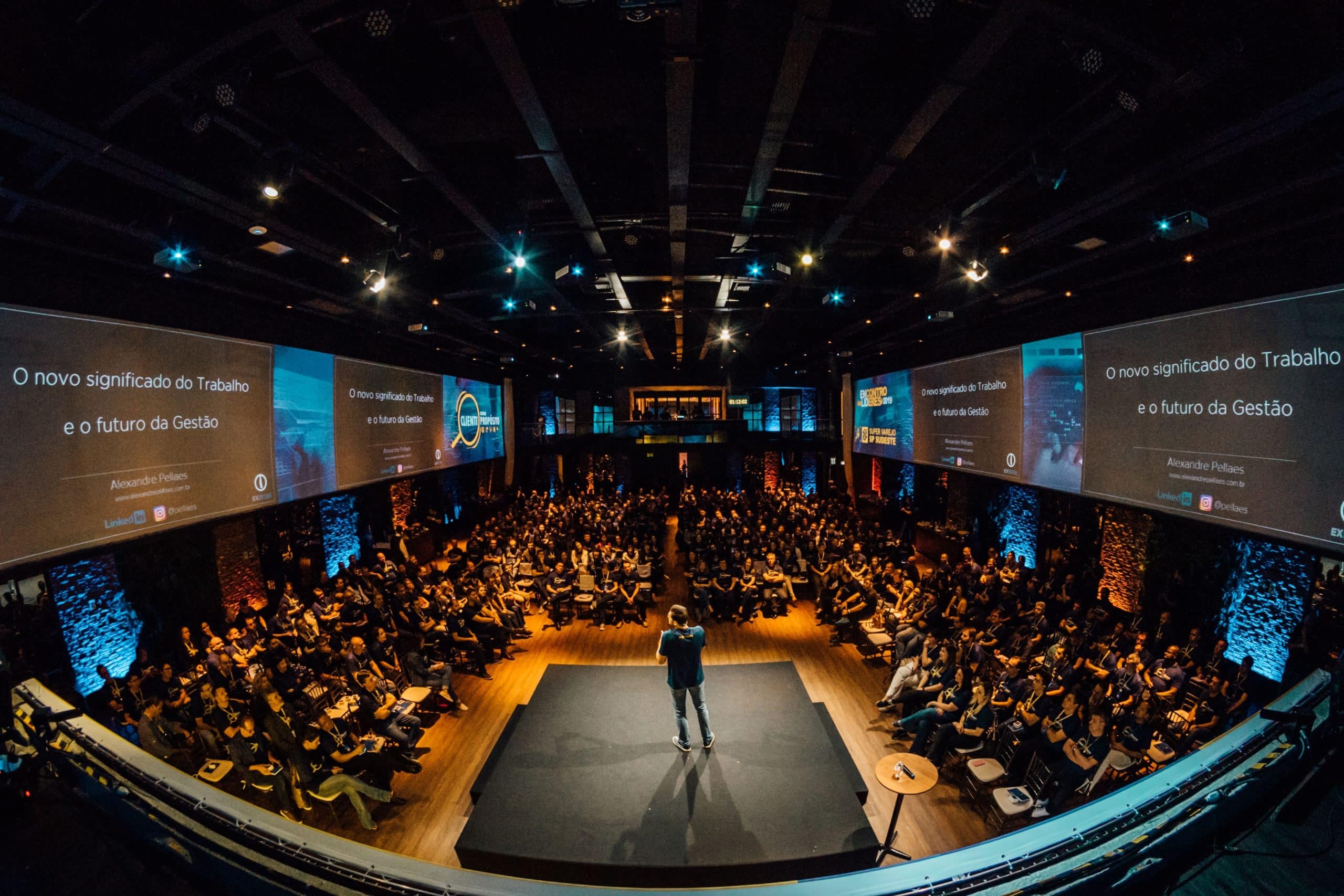
In August 2020, global events company, Identity Group, released a study. They wanted to know what event type works in a post-pandemic world and who would attend them. As you’ll guess, this research made headlines, evident in Shea Bennet reporting its findings for The Drum. Here are my highlights from Shea’s report for The Drum.
Only a third (33%) said they’d travel to attend events internationally in the next 12 months. On the other hand, an overwhelming 84% agreed to the statement, all events in the future should have both a virtual and live offering. In other words, events offering live and virtual options, or hybrid events, are the new normal. And it makes sense for institutions like yours keen on attracting and engaging international and out-of-state students. As a Higher Ed CMO (or CRM Manager), you should take this new normal of events as good news. Let’s see why.
Lucie-Kay Desthuis-Francis, a Strategy Consultant at CampusGroups, noted why the steady rise of hybrid events is good. She did this in an excellent piece titled Strategies to Make Your Hybrid Events a Success.
In the report, Lucie-Kay wrote:
Hybrid events have become the new normal for many campuses. While no longer a necessity, many colleges have seen them as an asset from both event management and student engagement standpoint.
So far, I’ve established two things:
- Hybrid events are the new normal, no questions there, and
- According to Lucie-Kay, they are assets from a student engagement and event management standpoint across various campuses.
But there are hard, unanswered questions: For an institution using Salesforce like yours, how can you effectively run hybrid events? More importantly, how do you turn them into marketing assets without tiresome manual data imports from multiple platforms? Well, grab a coffee because I’ll address these hard questions in this guide. Specifically, you’ll see how other Higher Ed campuses smoothly run hybrid events in Salesforce and adapt everything to their specific business needs:
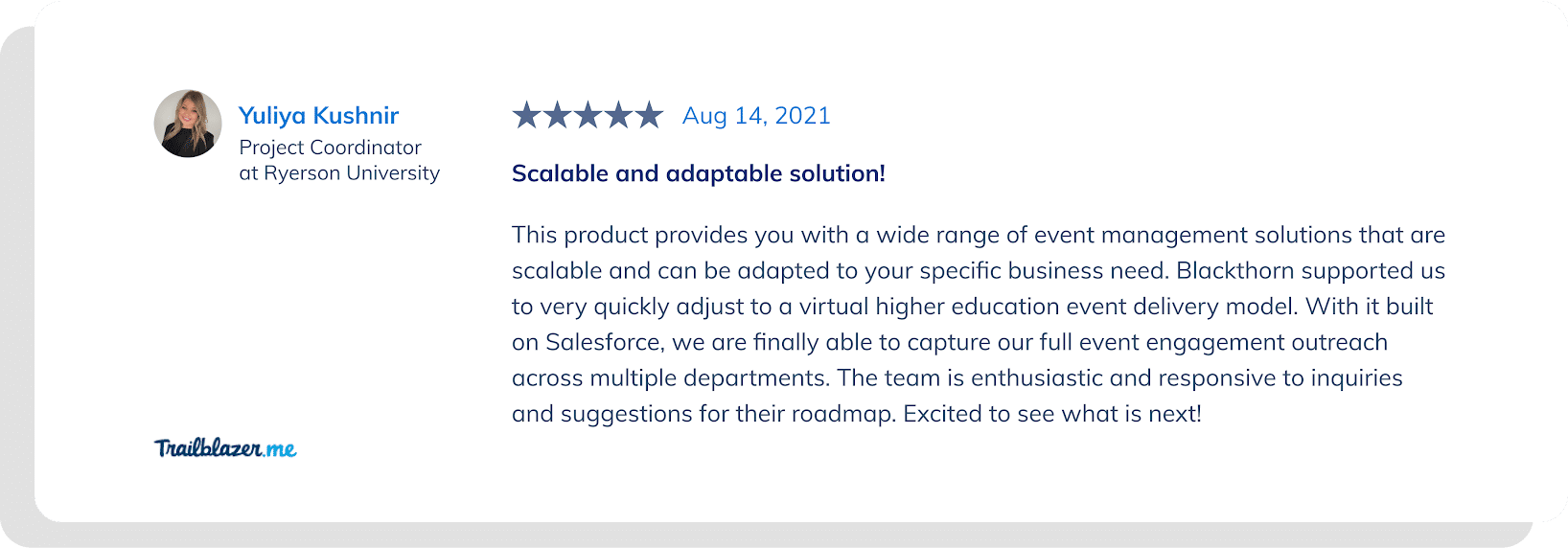
What Is Hybrid Events for Higher Eds?
Let’s start with what these event types are not. On the Trade Show University for Virtual & Live Events Podcast, Anca Trifan, CEO of Treefan Events, highlighted what hybrid events aren’t.
The three things she pointed out were:
- A hybrid event is not one where the live attendants are the main attraction,
- Hybrid events are not live streams, and
- A hybrid event is not about sharing on-demand video.
Defining what these event types are to Higher Eds, Anca said:
A hybrid event is the seamless integration of technology to facilitate the participation of both your in-person and virtual audiences.
In other words, hybrid events involve using tech to connect two audiences (in-person elements & online components) with a shared purpose. And it’s crucial to do this without making either feel disconnected or less important.

Fail to make this connection (as seen above) seamless, and you’ll get no ROI for all your team’s efforts or technology investments. But don’t worry. You’ll soon see how your entire org can make this vital connection (and reap the full benefits) with Blackthorn’s native Salesforce app. Before that, let’s differentiate hybrid from other event types.
Difference Between In-person, Virtual, and Hybrid Events
In-person events need no introduction. It’s the traditional campus events from before the advent of video platforms like Skype, Webex, Zoom, GoToMeeting, etc. Continuous innovation by these video platforms gave rise to online streaming and virtual events.
Today, the global coronavirus pandemic accelerated the adoption of virtual events. This, in turn, necessitated the rise of hybrid events, which has profound benefits in their own right:
- People could attend from all over the world
- Fewer logistics and lower costs for event managers
- More flexibility for attendees to take part on their own time.
- Better ways to engage students (or alumni) inundated with a myriad of activities.
Thankfully, students seem to love hybrid events platforms. Take Hannah Barker, a 3rd year Bristol University student, for instance. In an interview with Uni & Students Representative Bodies startup, Ayda, she shared her pleasure with her campus adopting hybrid platforms. Hannah said:
As a student, [we’re] inundated with events, experiences, and opportunities, but sometimes it isn’t possible to attend them all. Hybrid event platforms enable students to have the possibility to engage with all student events from the comfort of [our] student halls, library, or anywhere else in the world!
Advantages of Hybrid Events for Higher Ed CMOs
Students of this generation are quick to adopt new technology. They will jump gladly on what’s trendy, especially if it makes life easier for them. Hybrid events are no exception. But for someone leading an institution’s marketing department, giving students and alumni this desired hybrid experience comes with considerations:
- What advantages do hybrid events, and the platforms that make them possible, offer?
- And are they even worth the investment?
The answer to both questions is a resounding yes. In short, key advantages of going hybrid with your events are:
- Broader reach & increased attendance: With hybrid, you’ll accommodate more people (especially international students/alumni). And your event organizers no longer have to worry about venue size. All these lead to more attendees, brand awareness, and conversion opportunities.
- Audience engagement insights: Hybrid events allow virtual attendees to engage via comments or submitting live questions. But that’s not all. In-person attendees, knowing they can engage online, are likely to engage their remote counterparts too. All these give you valuable engagement insights for your Salesforce Marketing Cloud campaigns.
- Better event management & data capturing: Going hybrid simplifies how you manage and capture data from your events. And with a platform built natively to enhance event marketing on Salesforce, you get all the pre-and post-event data needed to power your team’s campaign efforts.
These benefits (and many others) makes Blackthorn the platform of choice for organizations using Salesforce:

Hybrid events have many advantages, as I’ve just highlighted. But like any good thing in life, to reap its benefits, you must overcome challenges when planning them. Let’s see.
A Core Challenge of Planning Successful Hybrid Events
Most schools trying out hybrid events face this problem. After paying so much for an expensive tech stack, they find it hard to measure hybrid events impact on their business growth. And that brings me to you. Your institution’s data lives in Salesforce. But do your hybrid events begin in Salesforce? If not, you’ll face one challenge most campuses face:
Data silos!
To explain, Markletic conducted studies that uncovered two troubling insights. First, over 71.1% of event organizers said connecting the in-person audience to their virtual audience was their biggest challenge. Second, most organizations (over 86%) only managed to realize positive hybrid events ROI seven months after they hosted the event.
These findings are troubling for these reasons. You must merge both audiences to ensure accurate data capture and availability, so your marketing team can nurture students and alumni until they convert. As per Markletic’s research, it could take about seven months. This makes hosting your hybrid events outside Salesforce a bad idea. Say your CRM manager wanted to quickly retrieve data for an event hosted six months ago on an app non-native to Salesforce. First, getting this data would be a stretch. You’ll also hope the Event Manager didn’t discard it, and even if they didn’t, you’d still have to juggle various platforms doing data imports.
Hope isn’t a strategy.
Neither should your team waste time doing manual data imports when they could be doing more strategic executions to grow revenue. Enter Blackthorn native Salesforce events platform. Blackthorn automates capturing all event engagement data like who registered, what sessions they registered for and attended, ticket details, and other data insights like preferences via our integrated custom form questions. Because it’s built right on top of Salesforce, Blackthorn retains your events data forever with relevant tags that make it readily available in your CRM.
That’s not all.
Our software captures and feeds very granular data seamlessly into your Marketing Cloud. So in a few button clicks, anyone with permissions can see very personalized data assets for running vital marketing campaigns:
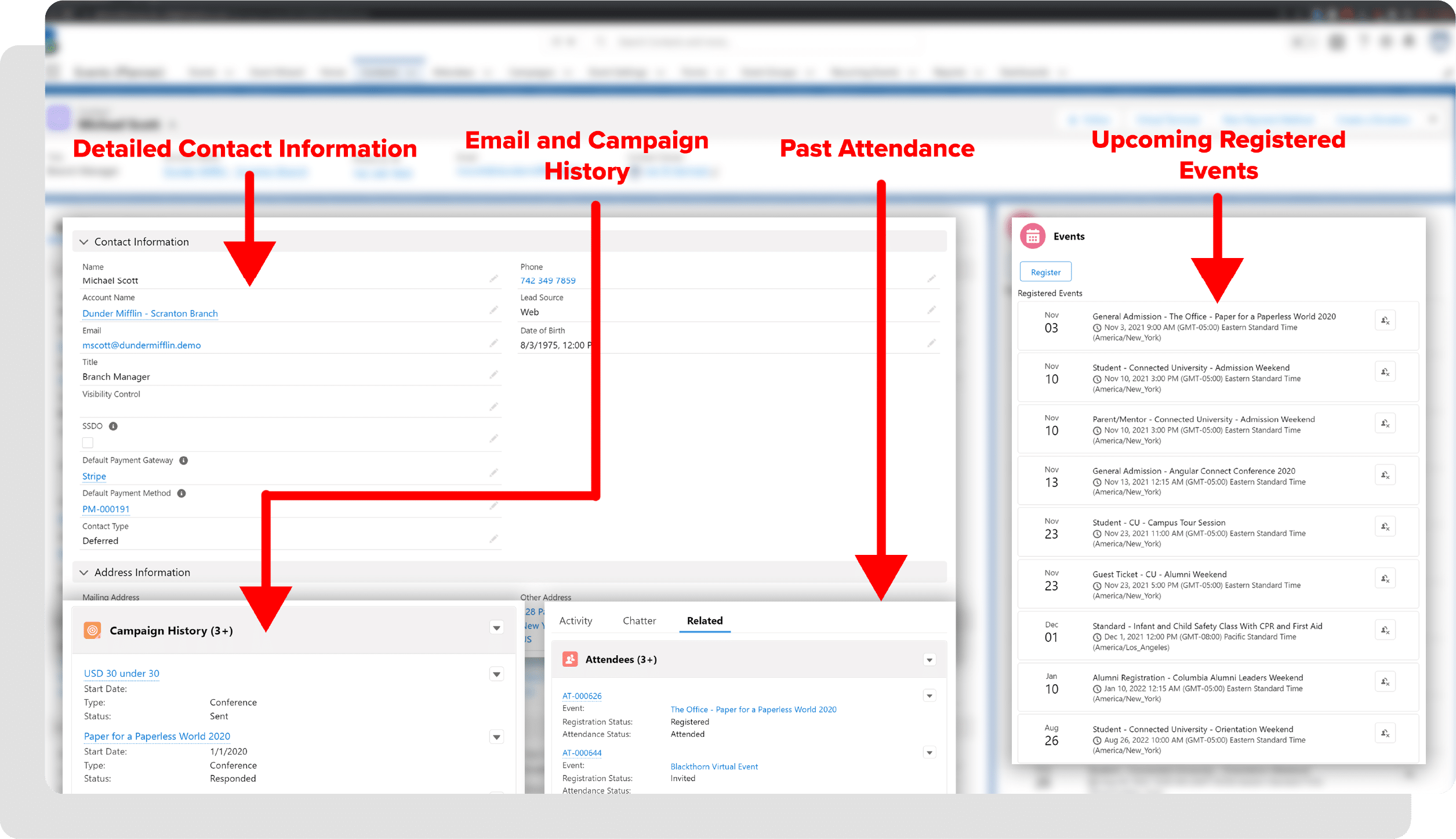
And don’t take it from me. Beyond giving you a 360-degree view of prospective students, active ones, and donors, Higher Eds also love Blackthorn for our proactive support:
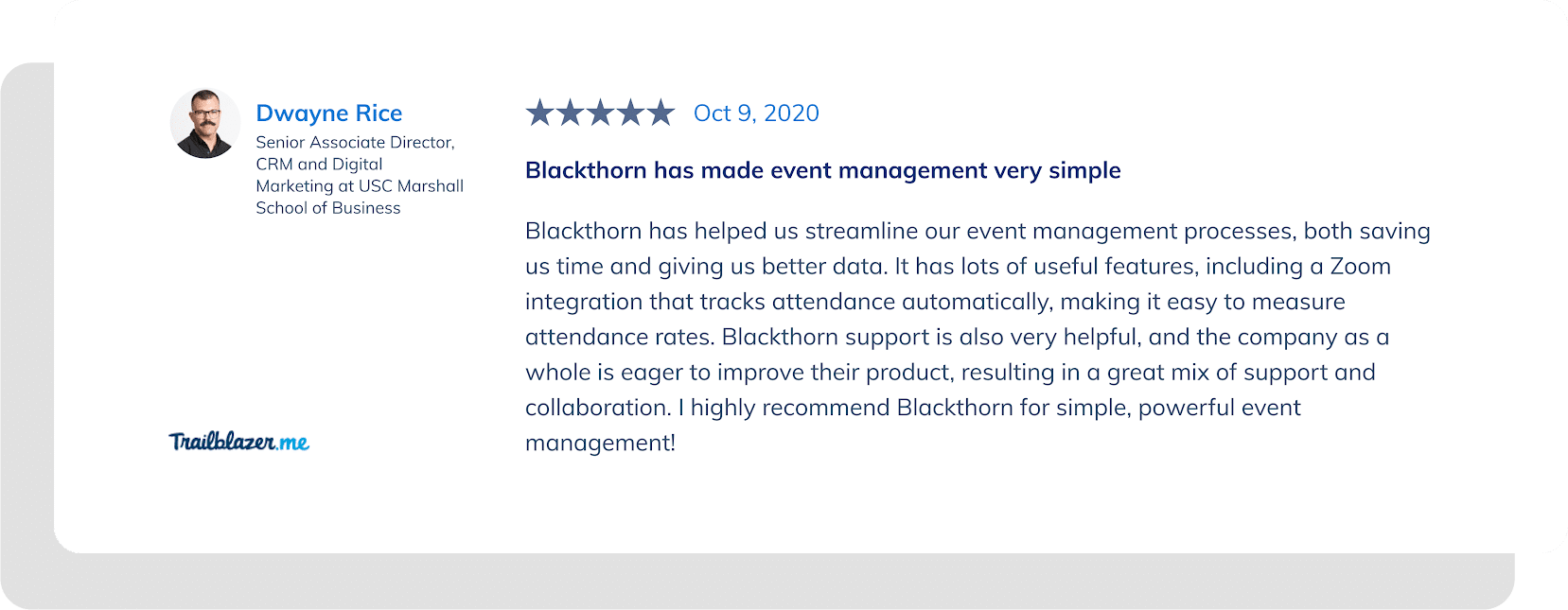
Things to Consider Before Hosting Hybrid Events
We’ve defined and gone over the many benefits of hybrid events. You’ve also seen how Blackthorn helps you overcome a crucial challenge Higher Eds face with hybrid events. Now before you dive in, here’s a quick list of things your team should consider when planning your next hybrid event:
1. Define Your Event Goals
Lawrence J. Peter was correct when he said:
“If you don’t know where you’re going, you’ll probably end up somewhere else.”
In other words, before making any move regarding your hybrid events, take a moment to outline your goals. Else, meaningful results may elude you. It helps to ask yourself questions like:
- What does my institution hope to gain from this event?
- What do my sponsors hope to achieve?
- And more importantly, what value would my attendees (in-person & virtual) get after attending?
It’s all about value. And it’s why Anca Trifan said:
Hybrid events have to be an experience that cater to all audiences in a viewer-friendly way. If you do put a lot of effort into planning this amazing attendee journey for your in-person participants, then you must apply the same care for your virtual audience as well to ensure that they get the most from the hybrid experience that you’re creating.
Focus your event goals on delivering value to everyone involved.
2. Understand Your Audience’s Attendee Journey
You’re the host; the audience (students or alumni) are your guests. As the host, it’s essential to map out the entire event attendee journey to give everyone who registers to attend a memorable guest experience. But what’s an attendee journey, you ask? It outlines the roadmap your attendees will experience at every stage of the event planning process. For instance, imagine Sarah was one person you were expecting at your event.
Mapping out an amazing attendee journey for her means asking yourself:
- How will Sarah, the enrollment prospect, feel about the whole registration process?
- Does she know what to do next after registering for the event?
- How easy is it for her to get in touch with an event staff?
- And how do we collect feedback during and after the event?
Asking these questions helps you identify weak spots. And correcting them helps improve your overall attendee experience.
3. Event Marketing & Promotion
Earlier, I mentioned how hybrid events attract more attendees. It comes as no surprise since you’re essentially opening the door to both virtual and in-person registrations. However, this doesn’t remove the need for creating enough awareness to lure your target audience. And that’s where event marketing and promotion come in.
There are several ways to do this:
- Leverage your institution’s alumni network
- Create event landing pages
- Use social media
- Consider paid ads
- Newsletters & email promotion
- Word-of-mouth & influencer
- Thought leadership posts.
WashU’s Olin Business School, for instance, uses paid advertisement, email marketing, and a live events calendar on its website. Like Olin Business School, an excellent promotion strategy is to have a full list of upcoming and recurring events on your website. And that’s because most online traffic goes there. So as alumni, current, and prospective students visit to browse the latest info, they’ll easily find and register for your event. Here’s how the events calendar (created on Blackthorn) integrates seamlessly into Olin Business School’s site:
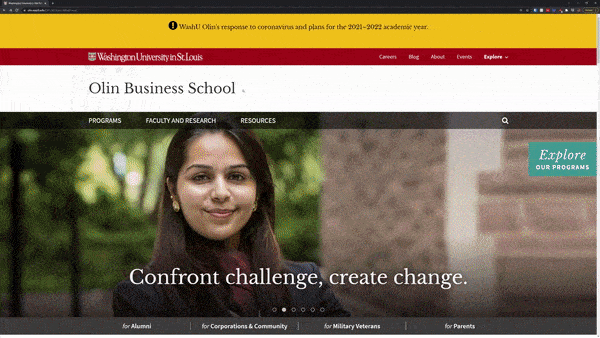
But promoting your hybrid events doesn’t end once people register. You also need marketing tools for follow-up campaigns. It doesn’t matter which one; Pardot, Marketo, Hubspot, Salesforce Marketing Cloud, etc. Once you connect your tool to your event campaign on Salesforce, Blackthorn also automates your email flow, saving your team time and effort. For instance, say 3,000 people visit your events page. Once they register, they’ll all get a confirmation email, and the campaign details get updated and transferred to another list in Salesforce. Blackthorn Events automates this entire process. Your team only has to set it once. And you can be sure the right emails would go out at the right time and the correct records updated instantly in Salesforce.

Choosing the Right Hybrid Events Platform
Choosing the most suitable platform is a struggle for many. In fact, Markletic reports that more than 67% of event organizers struggle to find the right technology to ensure a smooth hybrid hosting experience. And it begs the question: What should a Higher Ed organization using Salesforce look for in a hybrid events platform? The shortest, most important answer is:
- Compatibility with Salesforce
Let’s expand this short answer a bit.
Compatibility with Salesforce: Its Importance to Hybrid Events
Salesforce is a very complex software. The last thing you want to do is add to its complexity by hosting your hybrid events on apps that aren’t native to Salesforce. Insist on an event platform that plays well with your Salesforce system. I’m not talking about non-native apps with integrations for Salesforce. Such platforms aren’t built on Salesforce. Yes, they may have integrations, but they won’t give you a seamless experience. Why is this crucial, you ask?
It’s simple.
To have all your event data in one place and maximize the use of Salesforce, your best option is a Salesforce-native event app. With Blackthorn, there’s no need for extra integrations as your software lives 100% inside of Salesforce, right where the rest of your data lives. What does this mean for you, your Salesforce Admin, and others?
Four things:
- Data about your institution and its inhabitants is crucial. You’ll rest easy knowing it’s in a single and safe place rather than having some of it stored in a potentially susceptible server somewhere, right? That’s one advantage a Salesforce-native app brings you.
- A Salesforce-native event platform follows all security settings your Salesforce admin has set, meaning all your event attendees private data never goes out of Salesforce.
- The third reason is data accuracy. Your team members are humans susceptible to mistakes despite their best efforts; they’ll make mistakes adding events data manually into Salesforce. A native event app removes the risk of human errors by updating all your events data in real-time, giving you a 360-degree view of attendees, students, alumni, etc.
- Finally, your institution already uses Salesforce. Using a Salesforce-native event software will facilitate adoption and help you maximize ROI.
Other essential features to look out for when choosing a hybrid events app are:
- A flexible mobile app for checking-in
- Audience engagement features
- Marketing integration
- Proactive customer support.
All these add up to give you an all-encompassing and flexible Salesforce-native event management platform. And it’s for these exact reasons Higher Eds choose Blackthorn:

I’ll soon walk you through how your team can create hybrid events in Salesforce step-by-step. But before then, let’s explore two pillars crucial to a great event.
Two Pillars of Great Hybrid Events
Making the right considerations. Exceptional preparations. Choosing the right platform. Giving guests smooth attendee journeys. These are all paramount. But they can’t replace these two pillars.
1. Content
What’s at the core of all memorable hybrid events? It’s engaging content! Deharshi Chaudhury, the CEO of Quantilus Innovation Inc., agrees. Deharshi is also a Forbes Technology Council Member. In one of his Forbes articles, he highlighted the critical role of engaging content in hybrid events. Deharshi wrote:
Plan engaging content. Whether the audience is physically present or virtual, attendees registered because they have an interest in the event’s subject matter. Focus on great content about your company, product, or service in the form of demos, “As, educational material, or special offers.
And how do you plan engaging content? Get your team to dive into your Salesforce data. Send out surveys. Talk to some people you’re hosting the event for. Get creative about all these, and you’ll gather the right info for developing content that moves your audience. Once you’ve done this, infuse storytelling into your entire event content.
Nathan Gregoireis Fairfield University’s VP for Advancement Operations. In 2018, he co-authored an article highlighting why storytelling is vital for higher education content creation. Nathan and his co-author, Kimberly, wrote:
The pattern and necessity of storytelling are so deeply embedded into our DNA that stories will always be the single most powerful tool that we have to inform, persuade, and inspire others. Stories help us remember; they share experiences and help shape identity; they establish communities; they promote culture and values; they provide instruction; they reveal the past with the intention of shaping the future.
Grab the many lessons in those two quotes. Act on them.
2. Experience & Engagement
How people experience an event is subjective, so influencing it positively for everyone at the same time is a tough nut to crack. By default, your virtual and in-person attendees will experience content differently. It’s tough to crack, no doubt. But here’s a great place to start:
- Have control over the sound.
- Point your camera and lighting to illuminate the right things, at the right times.
- Ensure your event room’s design gives everyone (both virtual and in-person) a relaxing ambiance.
- And most importantly, manage your audiences™ expectations of the event.
Kelly Knowlen, Executive Director of Engagement & Special Events at Hilton, emphasized that fourth point on the Event Icons Podcast. She said:
“Set the expectations to understand what kind of engagement you want in advance.”
As noted by Kelly, managing your event’s expectations helps you improve engagement. After you nail that part, use these methods to drive engagement:
- Station virtual & in-person moderators
- Conduct Q&As
- Experiment with gamification
- Send out polls and surveys during the event
- Plan for breakout sessions
- Encourage collaboration.
How to Create & Manage Hybrid Events In Salesforce, Step-by-Step
1. Install Blackthorn & Provision Licenses
Blackthorn gives you a holistic approach to events management in Salesforce and also has payment processing built-in. This means to provision licenses across your organization; you’ll just install Blackthorn Events and Blackthorn Payments. The entire process is easy and thoughtfully outlined in our documentation:
[Here’s the entire process outlined in our step-by-step documentation page]
Once the initial setup is complete, the rest is a breeze.
2. Create Your First Hybrid Event with the Event Wizard
No one has the time to learn new software. The Blackthorn team understands that, so to help facilitate your first hybrid event creation, we launched the Event Wizard:
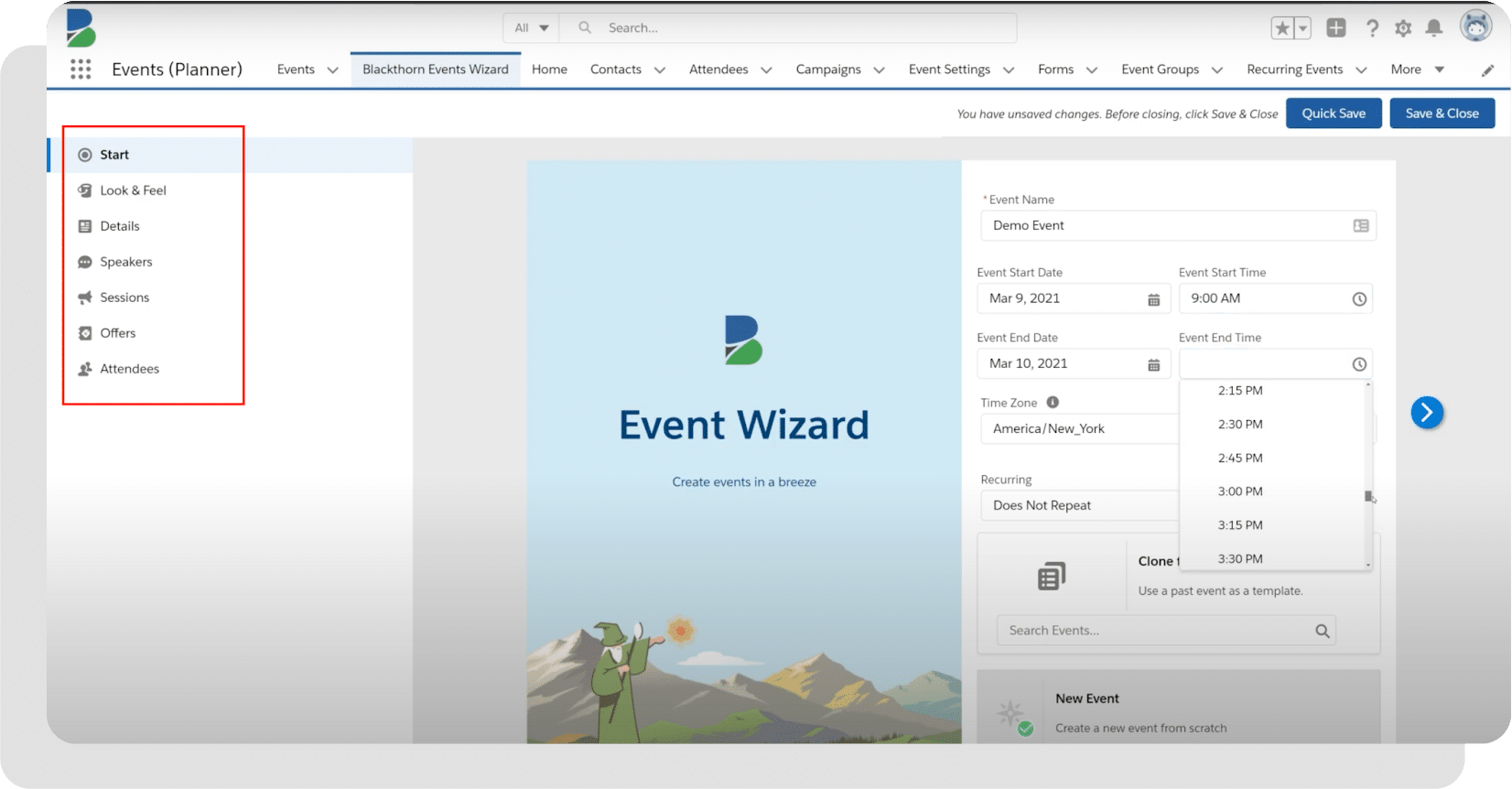
On your Salesforce App Launcher, search for Blackthorn Events Wizard. This search takes you to our intuitive Wizard environment (as shown above). By following the on-page prompts or clicking on outlined options on the left-hand menu, your event will be up and running in no time.
Start by choosing the Look & Feel of your hybrid events:
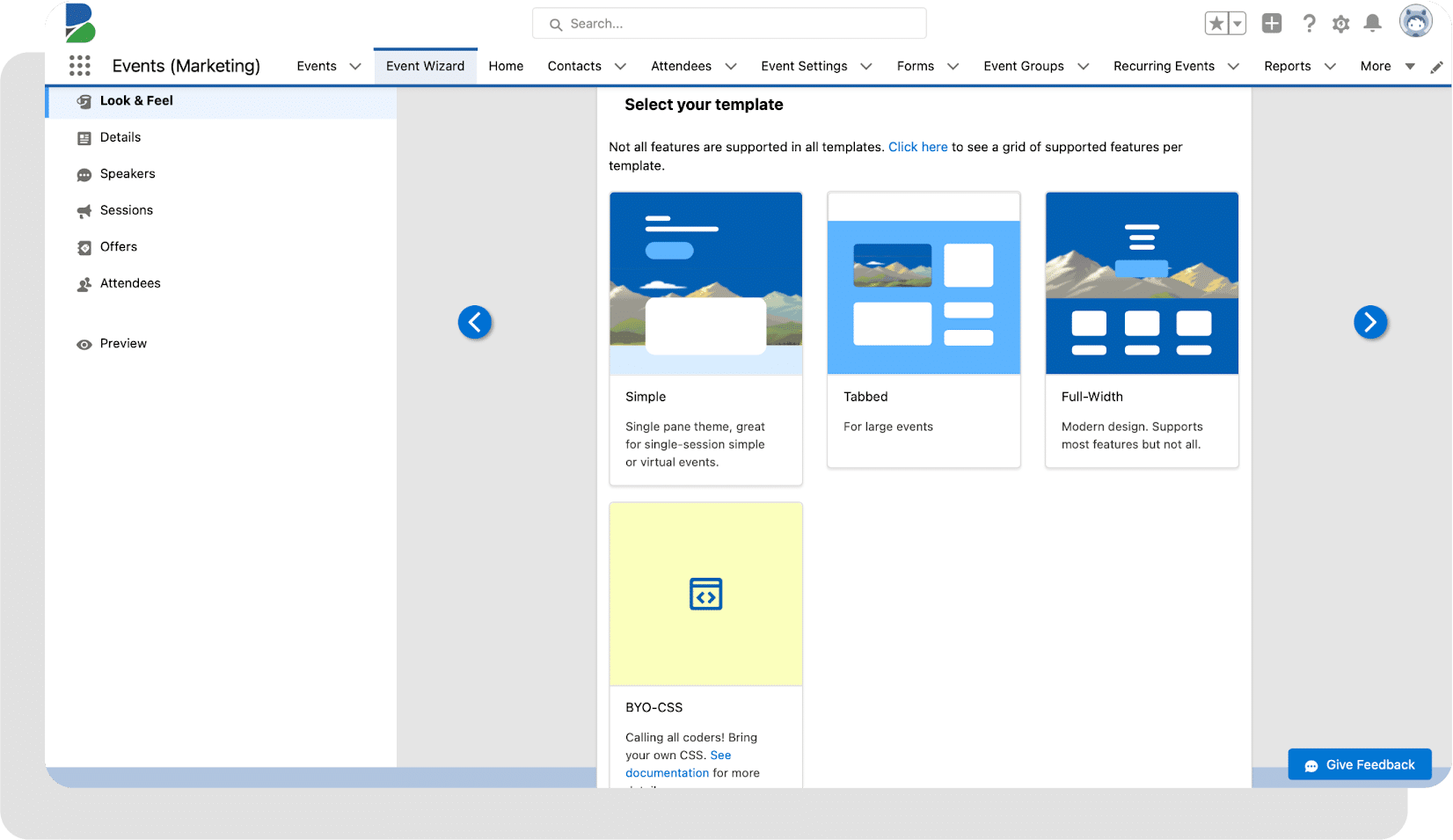
There are pre-built Look & Feel themes to choose from. But since you™re creating a hybrid event, I recommend going with the Tabbed theme. Want something customized to your specific tastes? No problem.
As shown in the screenshot above, you also have the option to add your CSS to maximize customization. Also, the Event Wizard guides your team through event ticketing, adding speakers and breakout sessions, previewing what the event page will look like, and other customizable features. Customization combined with ease of use is among the many reasons Higher Eds (and even non-profits) love Blackthorn.
Well, hear it from a happy customer:

3. Ease Attendee Registrations
Event creation isn’t complete until attendees register. It’s not also complete if your CRM Manager struggles to get attendees registration data into Salesforce. With third-party apps, the process is time-consuming because it involves manual data imports. Not with Blackthorn.
Create as many events as you desire in Salesforce. Clone previous events and change the details for new ones. When you’re ready, embed Blackthorn Events’ calendar component directly into your website:
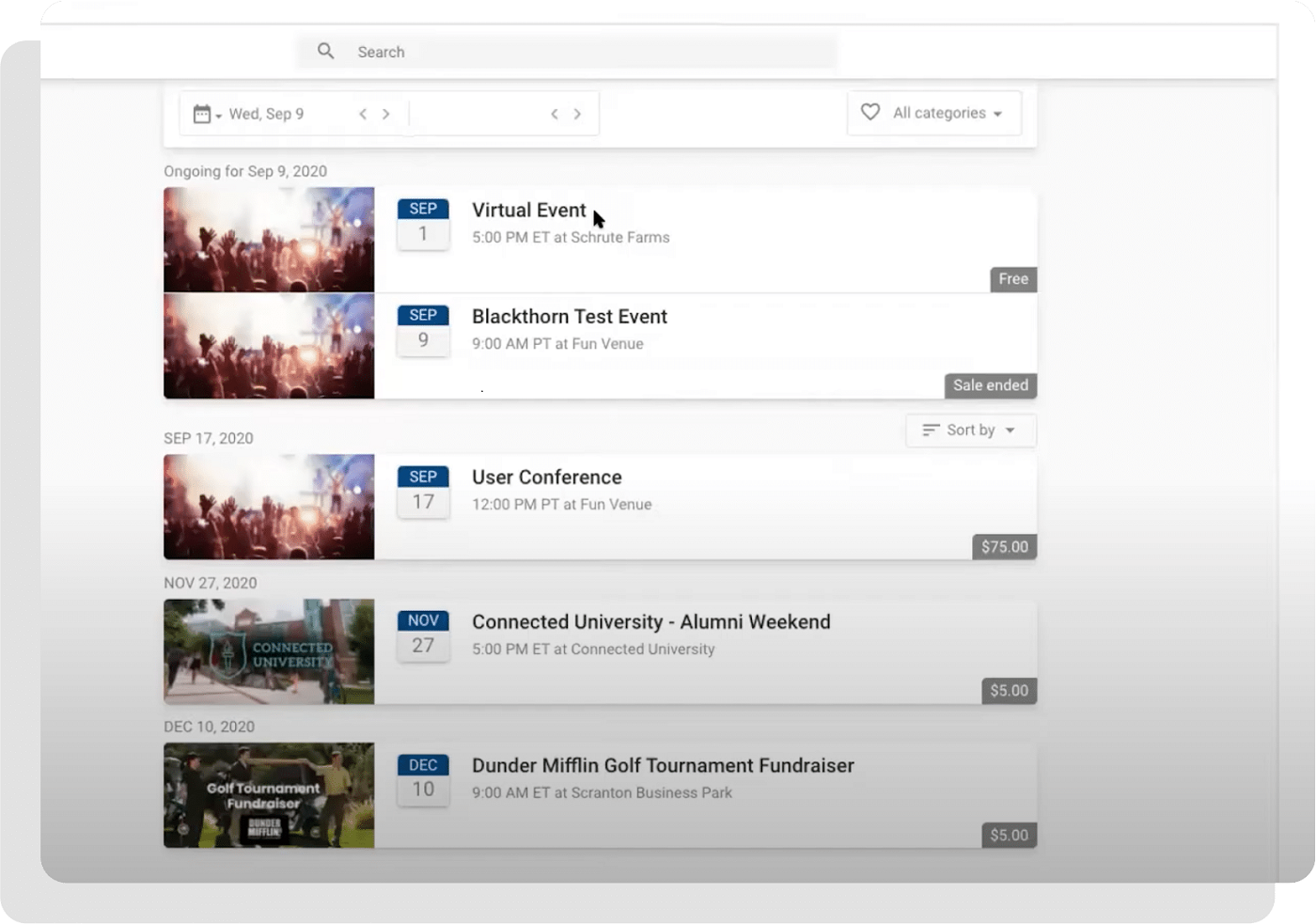
With this feature, attendees can search for specific events in specific categories based on the setup your team deems fit. And once they click on any event, they can register in a few clicks:

Blackthorn has a second way of helping you manage registrations. Because it’s on top of Salesforce, our app also integrates natively with Marketing Cloud. So once your event is live, you can automate campaigns to special invites, and they’ll easily register by clicking a few links in the email. Here’s an example:

And now to the best part.
It doesn’t matter if attendees register via the Blackthorn-embedded events calendar page or email. All registration info and attendee data their preferred payment method if the event was paid go straight into your Salesforce records without the need for third-party integration. For instance, here’s data for the example email shown above in Salesforce:
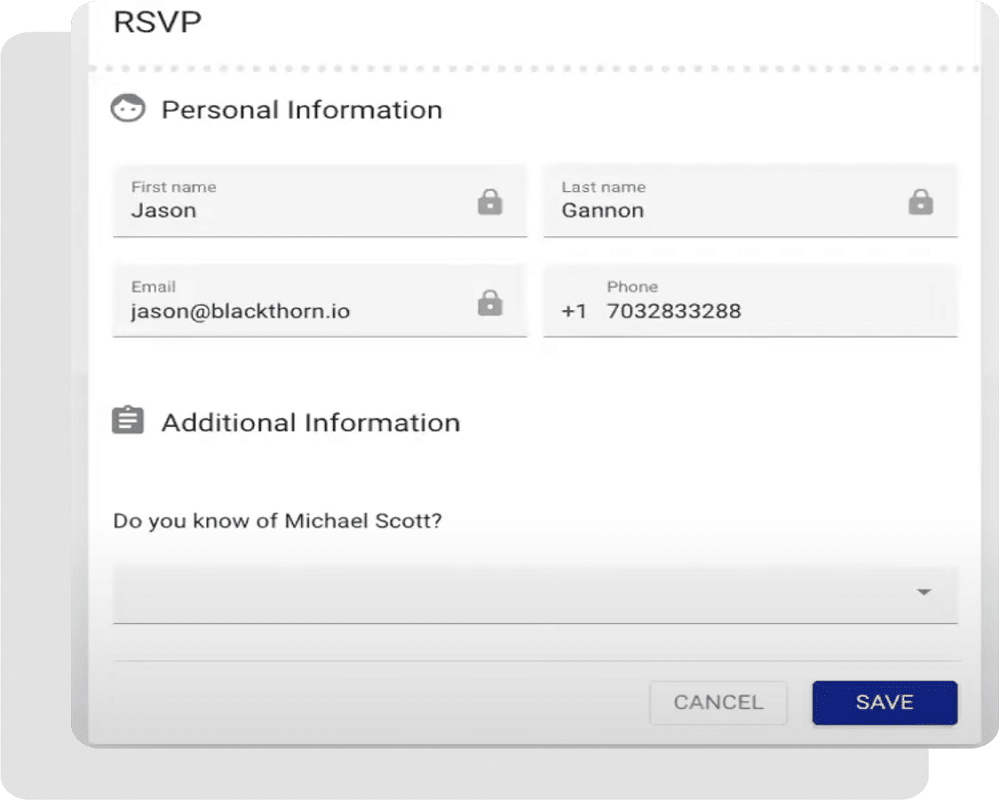
4. Measure Your Hybrid Event Success
We’ve made hybrid events fun to create in Salesforce. But we know CMOs (or CRM Managers) aren’t measured by how much fun events executed with hard-earned dollars deliver. Your event marketing success is measured by its impact on your institution’s business goals. A typical complaint we hear from companies who can’t track such goals is:
“We put $X towards events every year. We think they help drive engagement, but we can’t point to any metrics to help us confirm those assumptions. Neither can we leverage those metrics for marketing and sales objectives.”
Why does this happen, you ask? It happens when event metrics are siloed away from Salesforce CRM data. Or when an event platform cannot turn data into meaningful insights for powering marketing campaigns and driving revenue outcomes.
Enter Blackthorn Events. Being a Salesforce-native app, you can easily create reports and dashboards right inside Salesforce. In other words, where all your data lives:

Conclusion: Power Your Hybrid Events with Blackthorn
Michael Edwards is an event management consultant at eventSpace. In an interview with Kelly Frew on the Events for Breakfast podcast, Michael highlighted that the right technology sits nicely at the intersection of successful hybrid events. In his words:
The central nervous system to [bringing the two sets of participants in an hybrid event] is by having a platform where both attendee types can access information and can talk to each other.
Let me reemphasize Michael’s words. To give your hybrid events the best shot at success, you need the right technology. And this should be a comprehensive events platform creating, managing, and improving engagement before, during, and after your event. Again, Blackthorn Events come in:



